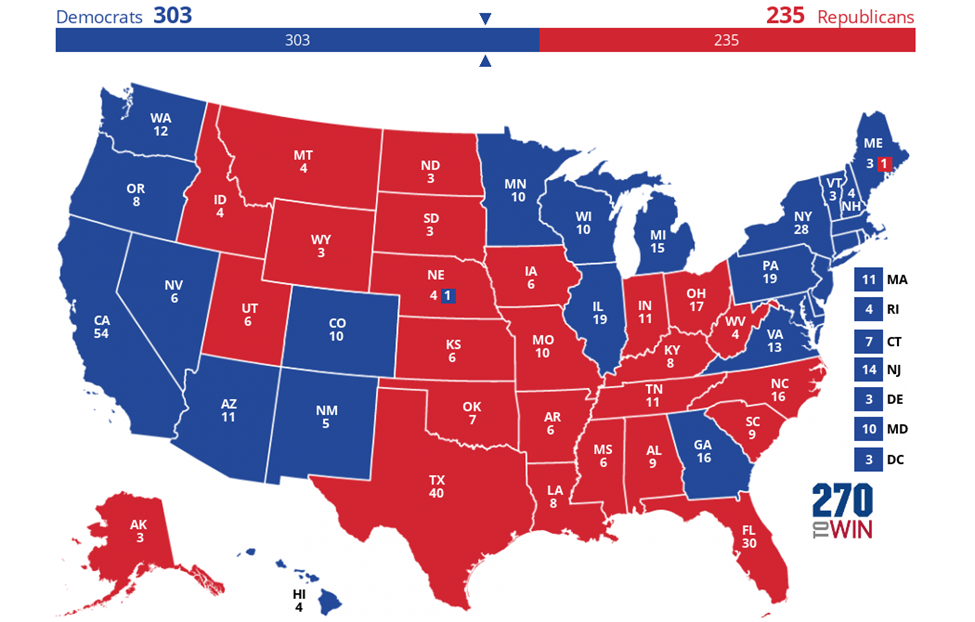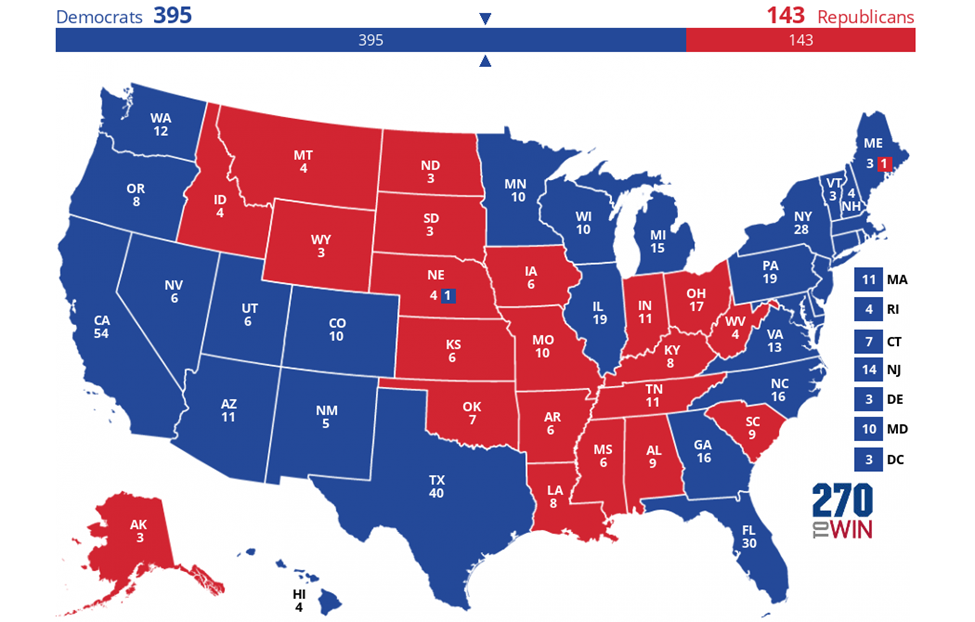
With six months to go until the 2024 Presidential Election, President Joe Biden will be facing former President Donald Trump: both men will be vying for a second term. We have an unusual scenario in which an incumbent President is facing a former President: something that hasn’t happened since 1912. And with both Biden and Trump looking to win a second term as President, there will be a lot riding on this.
While all 50 states in the United States are available to both candidates, very few of them can realistically be considered competitive, and we can predict with confidence how most of the states will vote. To that end, it is likely that the 2024 Presidential Election result will come down to seven key swing states: Arizona, Georgia, Michigan, Nevada, North Carolina, Pennsylvania and Wisconsin. Current polls show Trump leading in all of them; however, the actual election is still six months away, and anything can happen in that time.
With that said, in this article I will be considering a number of possible outcomes for the 2024 Presidential Election. Depending on what happens between now and November 5th, I will explain what might lead us to see these outcomes. It’s important to note that these outcomes are not projections of what I think will happen in each state in each case; rather, these are just examples of what we might see. Some of these scenarios are highly possible, while others are purely hypothetical. However, in every case, we will run through each of the possible scenarios.
The first three scenarios we’re going to look at are the most likely outcomes. Seeing as Joe Biden is the incumbent, we will start with an outcome in his favour.
1) Things remain as they are

Just as the 2024 Presidential Election is a repeat of the 2020 election, the first scenario we have also mirrors the previous election: in this situation, Joe Biden wins re-election to a second term, holding all the key swing states he picked up from Trump in 2020. While an identical repeat of the 2020 election is possible – as all Biden realistically needs to do is maintain his 2020 leads over Trump in the key swing states – there’s a good chance Trump could flip a couple of Biden’s key swing states. However, Biden could still afford to lose one or possibly two of the swing states he carried last time, like Arizona or Georgia, and still have enough Electoral College votes to get over the line. Polls currently put Trump ahead in each of the swing states, but if the polls settle in Biden’s favour over the next six months, then he will have a good chance of securing a second term.
2) Trump turns the clock back

This scenario shows what might happen if Donald Trump is re-elected to a second term: this is essentially a reversal of the 2020 result, turning the clock back to the 2016 election. In this situation, Trump wins all seven of the key swing states, winning back the states he lost in 2020, and also claiming Nevada, which has voted for the Democratic candidate since 2008. Given Trump’s present lead in the key swing states, as things currently stand there’s a good chance of him achieving this. However, it’s worth remembering that Trump only needs to flip as few as three swing states to secure a second term.
Which brings me to the third scenario.
3) A single state is the kingmaker

What is perhaps more likely than a repeat of the outcomes of either the 2016 or 2020 presidential elections – shown in the first two scenarios – is something between the two: if the poll gaps between Trump and Biden narrow over the next six months, we could see an incredibly tight race, in which the outcome of the election could possibly hinge on a single state. In fact, I would say an outcome like this would be the most likely. While current polls suggest Trump is leading across all the swing states, his leads are bigger in the Sun Belt states of Nevada, Arizona and Georgia. Thus, if we imagine that Trump performs better in the Sun Belt, for example, and Biden closes the gap in the Rust Belt, then we could see a scenario where the swing states are split between the candidates. With an even split, it could likely come down to a single state – perhaps Wisconsin – to determine who wins the election.
Of course, there is the risk that a result like this could take days or longer to declare, especially if some of the swing states are only won by a few thousand votes each. With Trump having already suggested he wouldn’t accept the result of the election in the crucial state of Wisconsin if he lost, be prepared for a lot of contention if the election ends up going this way; we could probably expect to see legal battles way beyond those of the 2000 Presidential Election. There is also the very real risk of an Electoral College tie, in which both candidates receive 269 votes and the individual states have to cast tiebreaking votes; right now I couldn’t imagine anything worse for the United States than that.
Scenarios like these three are by far the most likely. However, let’s take a look at what some less likely outcomes might look like if Trump or Biden perform even better than expected.
4) Trump hits back

In this scenario, Trump wins again, but issues such as the economy and inflation, border security and law and order – particularly regarding the recent college campus protests over Gaza – weigh more in the average voter’s mind when election day comes around. This increased concern, plus the electorate’s concern about Biden’s ability, pushes Trump’s victory a stage further than in 2016: he wins back the states he lost in 2020, and also extends his reach into more vulnerable Democrat-held states, such as New Hampshire and Minnesota, which he lost by 0.3% and 1.5% in 2016 respectively. New Mexico would be more of an outlier for Trump, but at this point it would be more likely to go red than Colorado would.
At this time, Trump is in a good position to flip a number of swing states red, but a scenario of this scale is definitely going to be a stretch for him.
5) Biden expands his coalition

On the other hand, imagine voters feel more strongly that they don’t want Trump to serve a second term as President, particularly if fallout from his ongoing trials negatively impacts his performance among swing voters. Meanwhile, in the last few months of his term, Biden has a good few months: the economy improves and he shows himself to be effective and decisive on key issues ahead of the election. These things help Biden to add new states to his tally, flipping states like Texas and North Carolina which are not completely out of reach for a Democrat. Even in a situation like this, I imagine Trump would keep his home state of Florida: with states such as Florida no longer being as competitive at the Presidential level, a new generation of swing states, including Texas, North Carolina, Georgia and Arizona will be in play. However, polls are not currently indicating this level of strength for Biden’s campaign, so I can’t imagine a Biden win at this point being much larger than the one he had in 2020.
6) Trump and Biden: back with a vengeance

Now, this last scenario is definitely a hypothetical one. A thumping victory is highly unlikely for either candidate, particularly one of this magnitude. However, the purpose of this scenario is more to show us how small changes could potentially have big impacts across the country: in these two maps, we show all the states that Trump or Biden could pick up on just a 5% swing in their favour, based on where polls currently stand at the time of writing: if Trump secures a further 5% swing from where things stand now, he could be claiming traditionally blue states like New Jersey and Oregon, and even Illinois might be on a knife edge. For Biden, more of the southwest would fall, and he would also be within reach of finally bringing Alaska to the Democratic fold: something which has become a Democratic ambition in recent years.

While outcomes of this scale are unlikely, in these days of what seems like increased partisanship, it’s useful to remember that a lot of states and electoral college votes are not as safe as they might seem.
So of the scenarios we’ve considered above, I would imagine that one of the first three outcomes will be the most likely. I can’t imagine at this point any major surprises happening outside of the seven key swing states we’ve discussed. However, winning the 2024 Presidential Election is not the only challenge Biden and Trump face in November: they also need for their parties to win in the elections to the Senate and House of Representatives.
With the Republicans holding a razor-thin majority in the House (just two at the time of writing) coupled with months of chaotic elections to the role of Speaker. The Republicans could well lose control of the House to the Democrats, even if Trump wins a second term as President. Meanwhile, the Democrats currently hold a 51-49 majority in the Senate; however, with Joe Manchin’s retirement in West Virginia, and with vulnerable Democratic incumbents like Jon Tester and Sherrod Brown seeking re-election in Republican states, it is likely that a 50-50 split in the Senate would be the best that the Democrats can hope for.
This election will be close. Like in 2016 and 2020, I wouldn’t be surprised if a few thousand votes going in three states. What is true however is that, when it comes to the 2024 elections, neither party looks to be in a particularly good position. For Joe Biden and Donald Trump, the Presidential Election is still either of theirs to lose. However, if a week is a long time in politics, then anything can happen over the next six months.